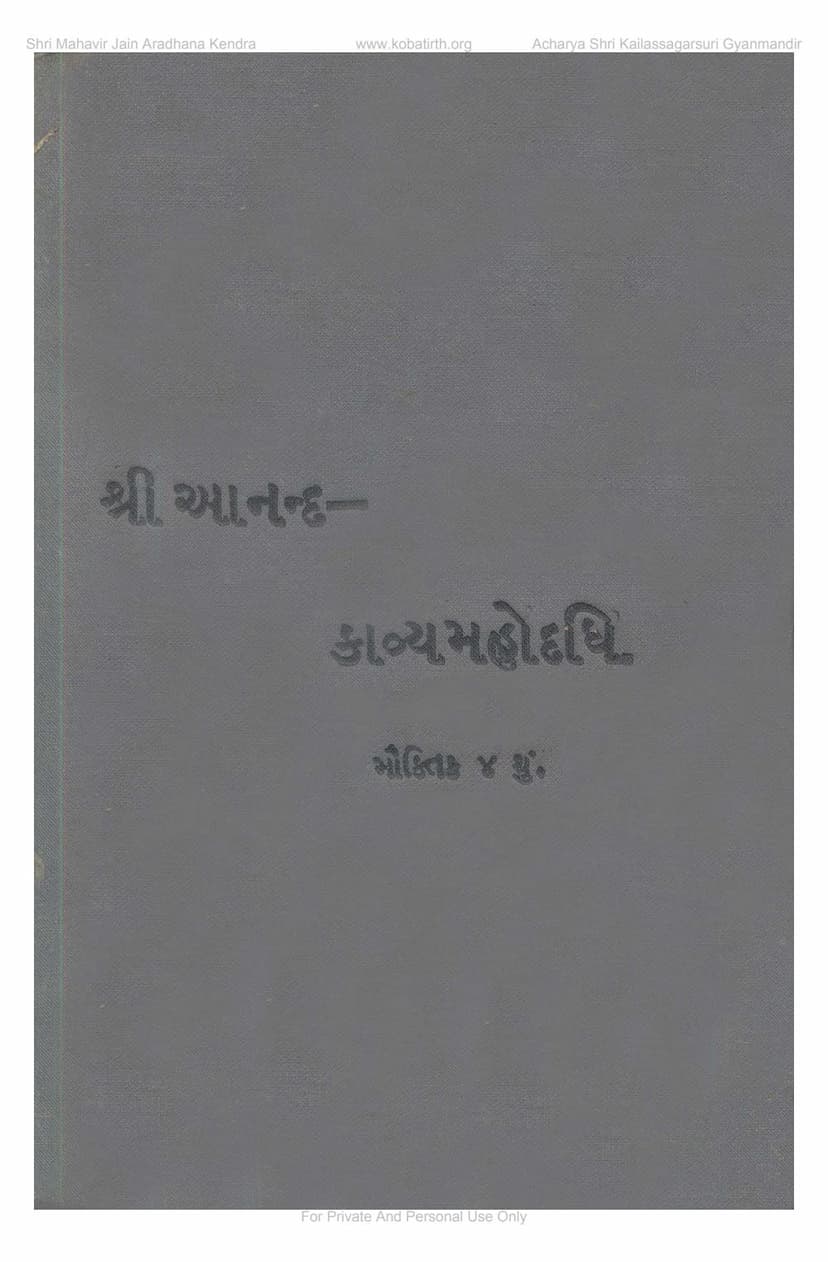Anand Kavya Mahodadhi
Added to library: September 1, 2025

Summary
Anand Kavya Mahodadhi (Ocean of Joyful Poetry) - A Comprehensive Summary
Book Title: Anand Kavya Mahodadhi (આનન્દ કાવ્ય મહોદધિ) Author: Buddhisagar (બુદ્ધિસાગર) Publisher: Naginbhai Ghelabhai Zaveri, Mumbai, for Sheth Devchand Lalbhai J. P. Fund. Catalog Link: https://jainqq.org/explore/008516/1
Overview:
The Anand Kavya Mahodadhi, authored by Acharya Buddhisagar Suri and compiled by Jivanchand Sakerchand Javeri, is a significant collection of old Gujarati poems. Published in 1915 by Naginbhai Ghelabhai Javeri for the Sheth Devchand Lalbhai Jain Pustakoddhar Fund, this book is part of a larger series aimed at preserving and promoting ancient Jain literature. The publication date (Vikram Samvat 1915 / Veer Samvat 1815 / Christ 1815, though the publication year is stated as 1915 on page 4) indicates its historical importance. The catalog link and the text itself confirm that it is primarily focused on the glorification of the Shatrunjaya tirth and its associated history, legends, and figures, presented in the form of verses (rasas).
Key Content and Themes:
The book is structured into various sections, each contributing to the overall narrative and glorification of the Shatrunjaya tirth. The primary content revolves around:
-
The History and Significance of Shatrunjaya Tirth: The text extensively details the paramount importance of Shatrunjaya (Siddhachal) as a holy pilgrimage site for Jains. It explains the concept of 'tirth' (pilgrimage site) as that which helps one cross the ocean of worldly existence, categorizing them into mobile (Jangam) and immobile (Sthavar). Shatrunjaya is repeatedly emphasized as the foremost among all immobile tirths.
-
The Glorification of Shatrunjaya: The text enumerates numerous names of Shatrunjaya, highlighting its spiritual significance and the immense merit gained by visiting or even remembering it. It describes how the spiritual aura of the enlightened beings who attained liberation there permeates the atmosphere, purifying the minds of pilgrims and aiding their spiritual progress.
-
The Shrutunjaya Mahatmya (Glorification of Shatrunjaya): The text traces the lineage of texts dedicated to glorifying Shatrunjaya, starting from the work of Pundarik Ganadhar during the time of Lord Rishabhdev, its concise form by Sudharma Swami, its essence captured by Dhaneshwarsuri in Sanskrit, and its eventual translation and adaptation into Gujarati as a 'ras' by Jinharsh Vacahak in the 18th century. This Gujarati 'ras' is the central piece of the collection.
-
Narratives and Legends: A substantial portion of the book comprises detailed narratives and legends woven into the 'ras' format. These stories illustrate key Jain principles and historical accounts, featuring:
- Lord Rishabhdev: The first Tirthankar, whose presence and influence are central to Shatrunjaya's sanctity.
- King Bharat: His conquest, travels to Shatrunjaya, and the accounts of his interactions during that period.
- King Bahubali: His story and achievements, particularly in relation to Shatrunjaya.
- Lord Parshvanath and Lord Mahavir: The lives and teachings of these Tirthankaras are also referenced, underscoring their connection to pilgrimage and spiritual exertion.
- King Shiladitya and Acharya Dhaneshwar Suri: The historical interaction between King Shiladitya and the Jain Acharya Dhaneshwar Suri is elaborated upon, detailing the King's conversion to Jainism and the subsequent flourishing of Jainism, including the compilation of Jain Agamas.
- King Vikramaditya and Acharya Siddhasen Divakar: The text mentions their pilgrimage to Shatrunjaya and the influence of Jainism during Vikramaditya's reign.
- King Bhavad and Javvad: The detailed life stories of Bhavad, a wealthy merchant who faced poverty but retained his devotion, and his son Javvad are narrated. Their journey involves a miraculous incident with a horse, their prosperity, and their eventual dedication to Jain dharma and the salvation of Shatrunjaya. This narrative is quite extensive, covering their lineage, the circumstances of their lives, and their connection to the tirth.
- Various other historical figures and anecdotes: The text mentions numerous other kings, merchants, and individuals whose lives are intertwined with the history and sanctity of Shatrunjaya, often highlighting their devotion, penance, and the miracles associated with the tirth.
-
The Nature of Tirths and Devotion: The text delves into the importance of visiting tirths, emphasizing that the merit gained from Shatrunjaya is manifold compared to other tirths. It stresses the significance of pure intentions, devotion, and adherence to Jain principles while undertaking pilgrimage. The text also touches upon the concept of 'upasarg' (obstacles) and how devotion can overcome them.
-
The Author and Compiler: The book acknowledges the efforts of Acharya Buddhisagar Suri for his research and editorial work in compiling and clarifying the ancient poems. Jivanchand Sakerchand Javeri is credited as the collector. The publication by the Sheth Devchand Lalbhai Jain Pustakoddhar Fund highlights a dedicated effort to preserve Jain heritage.
-
Linguistic and Literary Aspects: The text displays a deep understanding of Gujarati language, employing a rich vocabulary and poetic styles. The compiler mentions the challenges faced in obtaining pure copies of the original texts, acknowledging the presence of impurities and errors due to various transcriptions and printing issues. It also notes the historical context of the Gujarati language evolving from Sanskrit and Prakrit, emphasizing the importance of reaching the masses through their vernacular language.
-
Historical Context: The introduction and the narratives within the text provide glimpses into the socio-political and religious landscape of ancient and medieval India, mentioning various kings, rulers, and the prevailing religious practices, including mentions of Buddhism and its influence.
Structure of the Book:
The book begins with an "Avataranika" (Preface/Introduction) and "Prastavana" (Foreword), followed by the main content, which is primarily the 'Shatrunjay Tirthras' composed by Jinharsh. The 'ras' itself is divided into numerous chapters or 'dhal' (sections), each narrating a specific story, legend, or aspect of the tirth's glory. The latter part of the book includes a list of other books published by the Sheth Devchand Lalbhai Jain Pustakoddhar Fund.
In essence, Anand Kavya Mahodadhi is a devotional literary work that aims to educate and inspire the Jain community about their most sacred pilgrimage site, Shatrunjaya, through compelling narratives, historical accounts, and poetic expressions. It serves as a testament to the rich literary and spiritual heritage of Jainism.